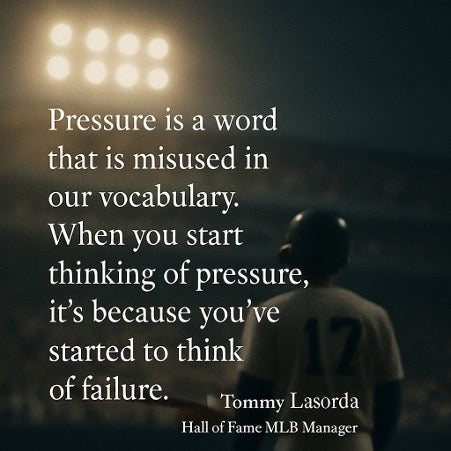
Pressure Is a Misused Word
“Pressure Is a Misused Word”: Rethinking Failure, Focus, and Leadership in High-Stakes Moments
“Pressure is a word that is misused in our vocabulary. When you start thinking of pressure, it’s because you’ve started to think of failure.”
— Tommy Lasorda, Hall of Fame MLB Manager
Shohei Ohtani is arguably the best player in Major League Baseball today. He originally made his mark as a once-in-a-generation dual pitcher and hitter. Now, after injury, he plays solely as a designated hitter for the LA Dodgers on a $700 million, 10-year contract. That’s $70 million a year—to hit. To perform. To carry expectation every single time he steps up to the plate.
That’s not just talent. That’s trust. And that’s pressure with weight.
Ohtani’s story, coupled with the Lasorda quote above, is what inspired this article. Because pressure in sport, business, and leadership may look different, but it shares the same core question:
What do you do when the moment finds you?
What if pressure isn’t the enemy—but the invitation?
Pressure is easy to spot in sport.
The final serve at Wimbledon.
The full-count swing in the bottom of the ninth.
A putt to win The Masters.
A Grand Final goal shot with seconds on the clock.
Moments that compress time and expectation into a single act. Where everything hinges on one decision, one movement, one breath.
These are the pressure moments we admire. But what about the ones we live through?
What about the pressure that doesn’t come with a crowd?
The kind felt in boardrooms.
In hospitals.
In start-ups trying to make payroll.
In leaders trying to navigate change, uncertainty, and expectation—every single day?
The Constant and Silent Nature of Business Pressure
In business and leadership, pressure doesn’t arrive as a moment. It arrives as a presence—quiet, persistent, and often unseen.
In sport, pressure is usually attached to a single moment. In business, it’s more often constant and silent. The pressure to perform. To lead. To show up. To not slip. To be accountable when the lines aren’t clearly drawn. This kind of pressure doesn’t scream—it lingers.
And while you can't always predict when it will come, preparation is what allows you to meet it with clarity instead of chaos. So don’t underestimate the value of preparation—even if it’s as simple as asking ourselves and exploring within each of us our "what-ifs." We don’t get daily serving or free-throw practice in business—but we can prepare by building a habit of engaging with these moments before they arrive.
That’s what separates the athlete’s pressure from the leader’s.
Not intensity—but visibility.
Character Under Pressure: What Changes, What Reveals
Some say pressure reveals character.
Others say it shapes it.
The truth? It does both.
Some people hesitate. Some feel overwhelmed.
But others rise—not because they’re stronger, but because pressure clears the noise. It focuses them. It calls something forward.
But that’s not the full story.
People change. They learn. They surprise even themselves.
And just because someone doesn’t thrive under pressure one day, doesn’t mean they won’t the next.
Pressure doesn’t define who you are—it creates space for who you might become.
And that’s the power in it.
Because the more we meet those moments—whether we fall short or rise—the more we build belief.
Belief that we can step in again. And again. And get better at it.
So maybe pressure isn’t a test of identity.
Maybe it’s a pathway to resilience.
And in business, as in sport, that might be the most valuable outcome of all.
Think of:
- Michael Jordan, who trained harder than anyone else so he could trust himself in pressure moments.
- Roger Federer, who described pressure as something to invite in, not push away.
- Simone Biles, who stepped away from Olympic competition not out of weakness, but clarity—recognising that true greatness sometimes means saying “not now.”
- Tiger Woods, who rebuilt his swing, his life, and his competitive mindset more than once.
- Serena Williams, who said, “I don’t feel pressure. I deal with pressure.”
And in each case, pressure wasn’t just endured.
It was transformed.
A Personal Reflection on Pressure
I’ve faced that kind of moment.
Years ago, I had to cancel a major element of a National Championship due to extreme weather and serious safety concerns—for participants, volunteers, and spectators.
It wasn’t a decision I sought—it found me. Which is often the case in leadership and crisis situations. It wasn’t going to be a popular decision whatever was decided. And it certainly wasn’t going to come with unanimous support.
But sometimes, as a leader, you find yourself in a position where a decision is expected. You seek advice, weigh everything you know, and make the call you believe is most appropriate—based on the risk, the responsibility, and the expectations placed on you.
In that moment, I asked myself a simple question:
“What decision could I better live with if the worst was to happen—based on the information I have now?”
That’s pressure. Not noise, not panic—just the quiet weight of knowing you’re accountable, and that someone has to decide.
Teamwork vs the Lone Hero: The Duality of Pressure
Pressure rarely exists in isolation.
In sport, great moments are often made possible by great teams.
One player might take the shot—but others made the pass, created the space, trusted the process.
The same is true in business.
Too often we expect leaders to withstand pressure alone. But no one does.
Not truly.
High-functioning teams absorb pressure together.
They create safety.
They give space for belief.
They distribute the emotional and strategic load.
Great leaders may carry responsibility—but great teams carry the pressure.
When pressure fractures a group, everyone breaks in silence.
When pressure unites a group, everyone performs—even when afraid.
Failure: Enemy or Fuel?
Let’s return to Lasorda’s quote:
“When you start thinking of pressure, it’s because you’ve started to think of failure.”
So the question becomes:
If failure didn’t matter, would we even feel pressure?
That might be the real pivot.
Failure isn’t always the enemy.
It’s often the motivator.
It’s the signal that we’re aiming high. That we’re stretching. That something matters.
The pressure you feel before launching a new product, making a career leap, or presenting to a board isn’t weakness—it’s meaning.
It’s your body saying: “This matters. Don’t waste it.”
If you’ve done the work—prepared, reflected, surrounded yourself with the right people—then pressure becomes an invitation.
Not to panic.
To rise.
Business Leaders Who Faced Real Pressure—and What They Chose Instead
Gail Kelly – Westpac During the GFC
In 2008, Gail Kelly became the first female CEO of a major Australian bank. Within months, the global financial system began to collapse.
Markets tanked. Liquidity dried up. Panic set in.
Her response? Not noise—but composure.
She focused on internal alignment, clear communication, and client confidence.
She knew pressure couldn’t be ignored. But it could be absorbed with grace.
Westpac emerged not just stable—but stronger. Because she didn’t try to conquer pressure—she partnered with it.
Satya Nadella – Rebuilding Microsoft’s Soul
When Nadella became CEO in 2014, Microsoft was seen as bureaucratic, arrogant, and creatively stagnant.
He didn’t chase new products. He didn’t cut costs first.
He focused on culture.
He introduced a “learn-it-all” mindset, replacing the outdated “know-it-all” persona.
He embedded empathy into leadership training.
And he made it personal—drawing on his experience parenting a child with disabilities.
Microsoft became a place where failure was allowed, learning was celebrated, and pressure wasn’t just about success—it was about growth.
Howard Schultz – The Starbucks Reset
Returning as CEO in 2008, Schultz found Starbucks diluted and distracted.
Stores were underperforming. Growth had become the goal, not quality.
He did something unthinkable:
Closed 7,100 stores for retraining.
Lost millions in immediate revenue.
And refocused the company on craft.
He understood that pressure could push you to chase results—or pull you back to purpose.
Starbucks chose the latter. And won.
Six Grounded Truths
1. Pressure isn’t always visible.
The quiet weight is often the heaviest. Honour it—even if others don’t see it.
2. Pressure doesn’t mean you’re failing.
It means what you’re doing matters. Let that guide you.
3. Some people thrive under pressure. Others learn to.
Neither is better. What matters is being honest about which one you are—and building tools around it. And we can all change
4. Preparation is power.
Rituals. Strategy filters. Reflection. When the moment comes, you won’t rise to pressure—you’ll fall to your level of preparation.
5. Give people their next “at bat.”
Trust builds belief. And belief, over time, becomes resilience. Don’t withhold that chance.
6. You can grow under pressure—if you stay connected to your team.
Pressure isolates. Teamwork reconnects. The best leaders distribute pressure so it doesn’t destroy culture.
Final Reflection
You may never face a crowd, a camera, or your ninth-inning moment.
But you’ll face situations that matter—those that come to you with pressure, often unexpected.
Just remember the outcome isn’t written……. until it is.




